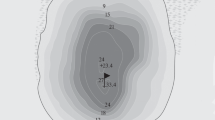Abstract—Data on the status of summer phytoplankton of the Usa River and its tributaries are given. In total 184 taxa of algae with a rank lower than the genus from eight divisions were recorded in algal flora, with Bacillariophyta (43–57% of the composition) and Chlorophyta (23–47%) predominating in the rivers. The abundance range in algocenoses was 0.02–5.2 million cells/L; of biomass, 0.01–1.8 mg/L; the content of chlorophyll-a, was 0.01–3.1 μg/L. The ecological heterogeneity along the watercourse causes significant dynamics in the taxonomic composition, which is characterized by mosaic distribution in different areas, and changes in the quantitative structure of plankton communities. An increase in the species diversity, abundance, biomass, and chlorophyll-a concentration from the source to the mouth of rivers is noted. The ecotone effect in the zone of mixing and transformation of the waters of the lower reaches of the watercourses and Usinskii Bay of the Kuibyshev Reservoir is expressed in an increase in the diversity and amount of algae, an increase in the coenotic role of Cyanoprokaryota and planktonic green algae of the Chlorococcales order, which are dominant in Usinskii Bay. The influence of hydrological conditions, the content of nutrients, and the anthropogenic impact on the formation of algocenoses is discussed. The taxonomic composition, distribution, structural characteristics of algocenoses in the absence of nutrient limiting depend on hydrological factors, and biotopic heterogeneity of natural and anthropogenic origin have been studied, whereas their relation to the content of nutrients in eutrophic conditions has not been revealed. The Shannon species diversity index varied from 0.5 to 2.7 bits/specimen in the river algocenoses. The minimum values were noted on the upstream sections of the rivers; the complexity of the structure is typical for the algocenoses of the mixing zones of the waters of the upper part of Usinskii Bay and the mouths of the Muranka and Tisherek rivers, as well as for the communities of the sections of rivers with anthropogenic impact.



Similar content being viewed by others
REFERENCES
Abonyi, A., Leitão, M., Lançon, A.M., and Padisák, J., Phytoplankton functional groups as indicators of human impacts along the River Loire (France), Hydrobiologia, 2012, vol. 698, no. 5, pp. 233–249.
Bioindikatsiya ekologicheskogo sostoyaniya ravninnykh rek (Bioindication of the Ecological State of Lowland Rivers), Bukharin, O.V. and Rozenberg, G.S., Eds. Moscow: Nauka, 2007.
Bouillon, V.V., Primary production and trophic classification of water bodies, in Metodicheskiye voprosy izucheniya pervichnoi produktsii planktona vnutrennikh vodoyemov (Methodological Issues in Studies on the Primary Production of Plankton in Inland Water Bodies) St. Petersburg: Gidrometeoizdat, 1993, pp. 147–157.
Ecological Bulletin, Samara region, July 2017. www.pogoda-sv.ru/docs/ecology…/sam_jul_2017. Cited May 12, 2018.
Fedorov, V.D., O metodakh izucheniya fitoplanktona i ego aktivnosti (Methods for Studying Phytoplankton and Its Activity), Moscow: Mosk. Gos. Univ., 1979.
Gorokhova, O.G., The composition and structure of phytoplankton communities of Usinskii Bay, Kuibyshev Reservoir, during alga bloom, Izv. Samarsk. Nauch. Tsentra Ross. Akad. Nauk, 2016, vol. 18, no. 5-1, pp. 122–130.
Korneva, L.G., Fitoplankton vodokhranilishch basseina reki Volgi (Phytoplankton of Reservoirs in the Volga River Basin), Kostroma: Kostromskoi Pechatnyi Dom, 2015.
Malyye reki Volzhskogo basseina (Small Rivers of the Volga Basin), Alekseevskii, N.I., Ed., Moscow: Mosk Gos. Univ., 1998.
Metodika izucheniya biogeotsenozov vnutrennikh vodoemov (Methods for Studying Biogeocenoses of Inland Water Bodies), Moscow: Nauka, 1975.
Mischke, U., Venohr, M., and Behrendt, H., Using phytoplankton to assess the trophic status of German rivers, Int. Rev. Hydrobiol., 2011, vol. 96, no. 5, pp. 578–598.
Okhapkin, A.G., The structure and succession of phytoplankton under conditions of regulated river flow (the example of the Volga River and its tributaries), Doctoral (Biol.) Dissertation, St. Petersburg, 1997.
Okhapkin, A.G., Dynamics of the species structure of potamophytoplankton in watercourses of various types, Inland Water Biol., 2000, no. 1, pp. 53–61.
Okhapkin, A.G. and Genkal, S.I., Ecology of mass diatom species in the plankton of watercourses of the Middle Volga Basin: species of the genera Aulacosira Thw., Melosira Ag., Cyclotella Kutz., Cyclostephanos Round, Sceletonema Grev., pennate diatoms, Inland Water Biol., 2001, no. 1, pp. 27–25.
Okhapkin, A.G., Gorokhova, O.G., Genkal, S.I., and Pautova, V.N., On the algal flora of the lower Oka River, Bot. Zh., 2010, vol. 95, no. 10, pp. 1422–1436.
Osobennosti presnovodnykh ekosistem malykh rek Volzhskogo basseina (Specific Features of Freshwater Ecosystems in Small Rivers of the Volga Basin), Rosenberg, G.S. and Zinchenko, T.D., Eds. Tolyatti: Kassandra, 2011.
SCOR-UNESCO Working group 17, Determination of photosynthetic pigments in seawater, Monographs on Oceanographic Methodology, Paris: UNESCO, 1966, pp. 9–18.
Zinchenko, T.D., Shitikov, V.K., and Golovatyuk, L.V., Specific features of the spatial distribution of benthic communities in a plain river in the Middle Volga Basin, Vestn. Tomsk. Gos. Univ., Ser. Biol., 2017, no. 40, pp. 163–180.
Funding
This study was carried out within the framework of the budget theme “Sustainability and Productivity of Aquatic Ecosystems Based on Analysis of the Diversity of the Biotic Components of the Lotus and Lentic Ecosystems of the Middle and Lower Volga Basins, Their Ecological, Biological, and Structural Changes in Natural Conditions and under Anthropogenic Impact” and with financial support from the Russian Foundation for Basic Research, project no. 17-44-630197.
Author information
Authors and Affiliations
Corresponding authors
Ethics declarations
The authors declare that they have no conflict of interest. This article does not contain any studies involving animals or human participants performed by any of the authors.
Additional information
Translated by D. Pavlov
Rights and permissions
About this article
Cite this article
Gorokhova, O.G., Zinchenko, T.D. Phytoplankton of the Usa River and Its Tributaries (Kuibyshev Reservoir Basin). Biol Bull Russ Acad Sci 46, 1382–1389 (2019). https://doi.org/10.1134/S1062359019100121
Received:
Revised:
Accepted:
Published:
Issue Date:
DOI: https://doi.org/10.1134/S1062359019100121




